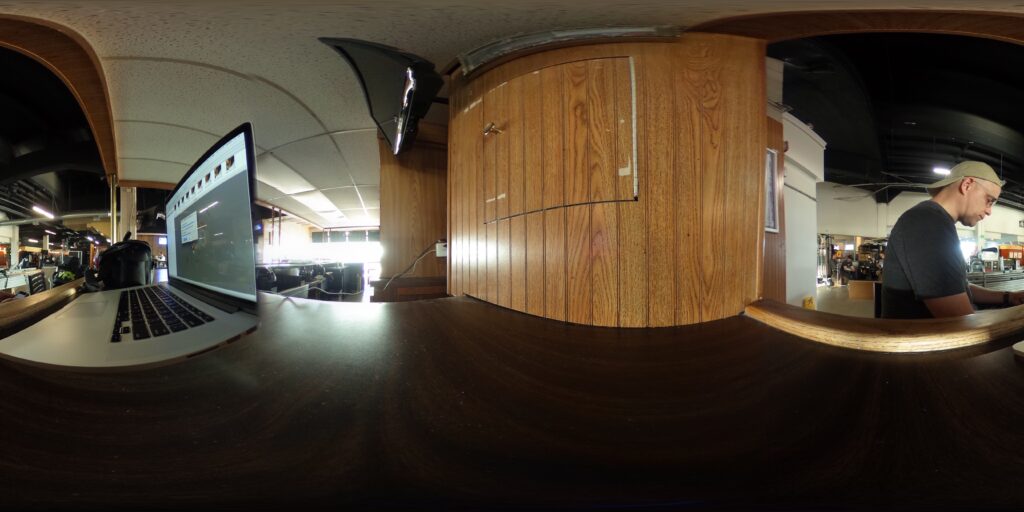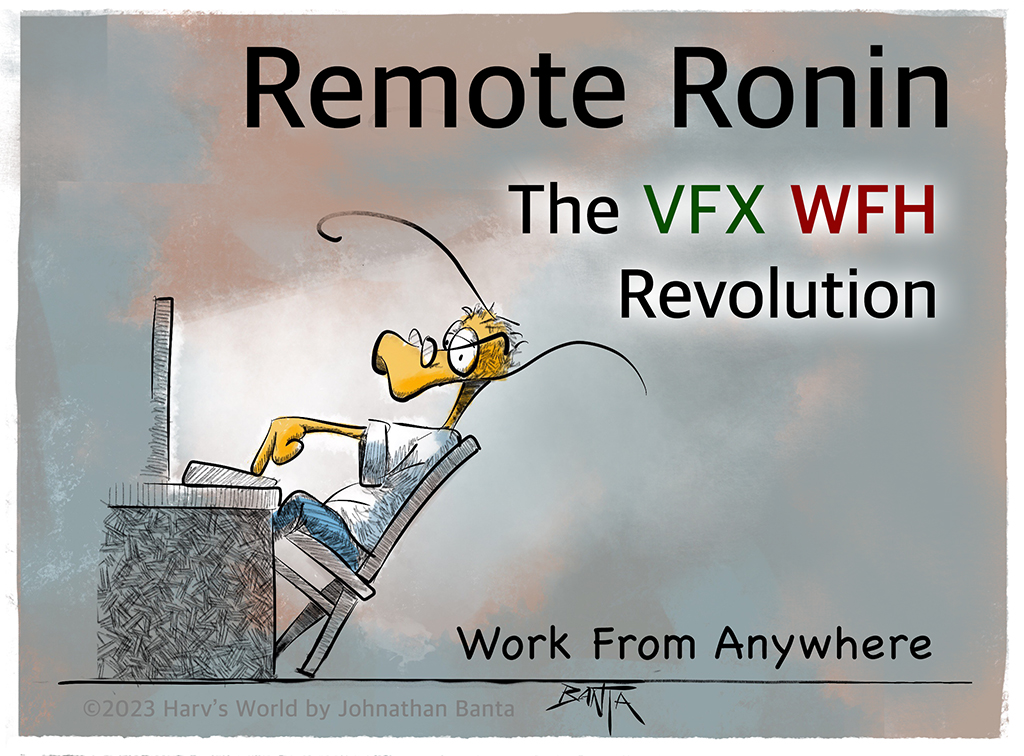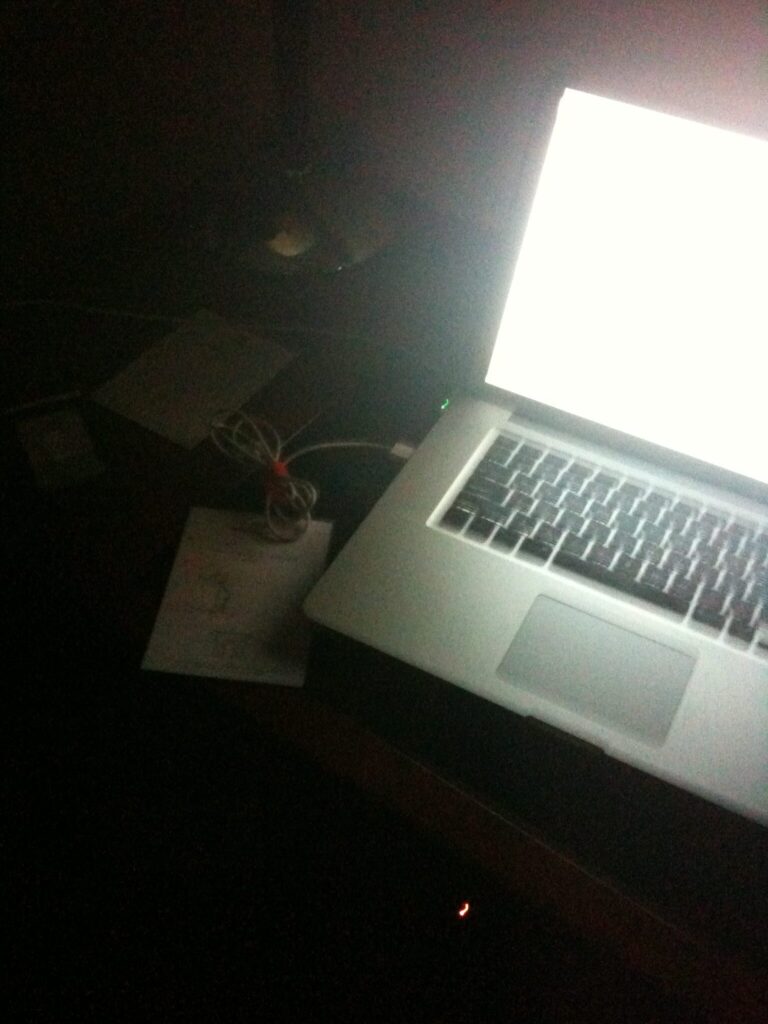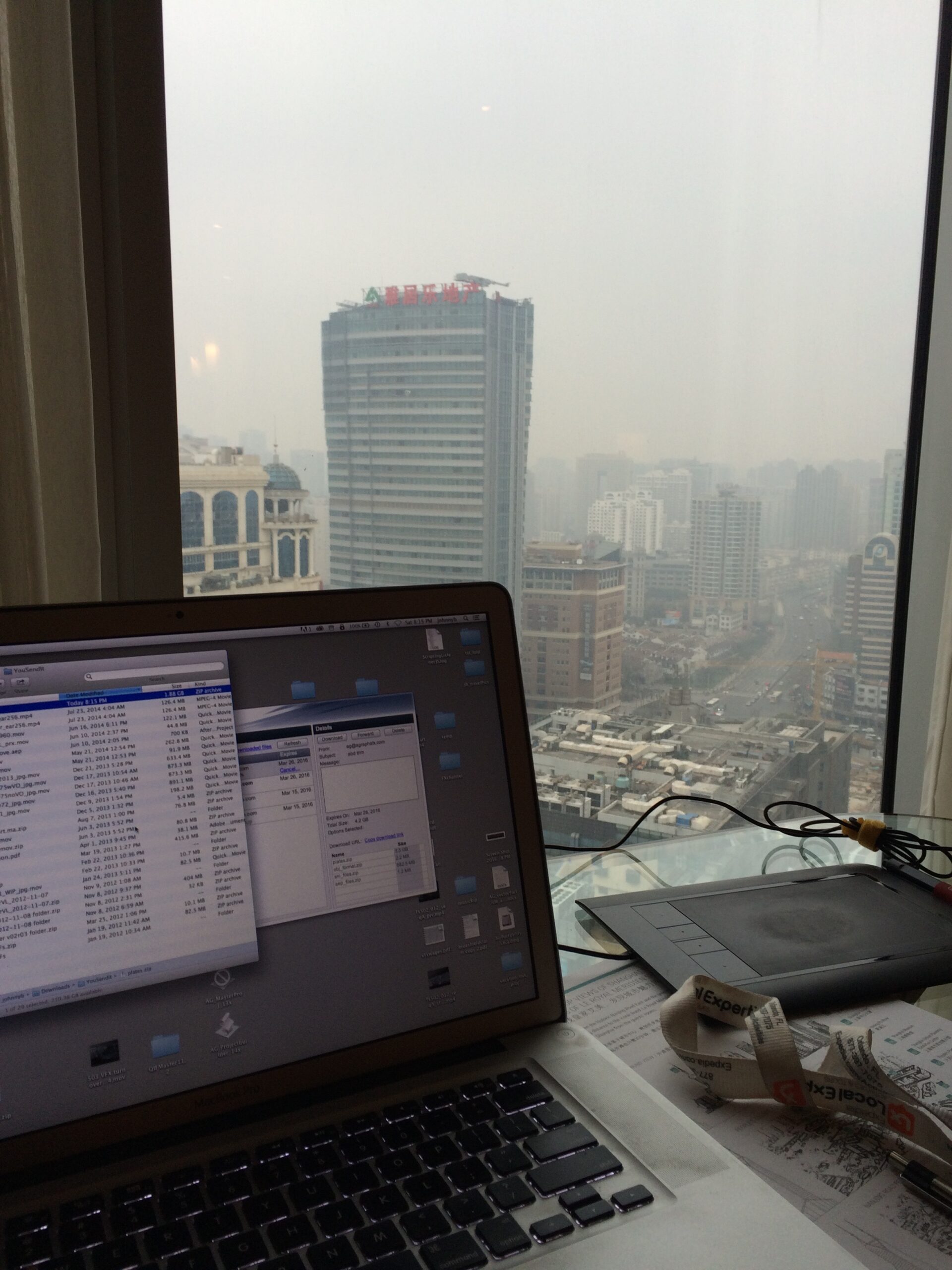
Have Laptop Will Travel
Recently, a producer friend of mine mentioned that I’ve worked remotely for a very long time, even before the lockdowns and before the remote shops popped up in the mid-2000s. With a hearty laptop (the first one courtesy of Tim Sassoon), and a good home setup I’ve literally worked around the globe. I was the guy who rode up on his bicycle at an edit suite, slapped down a computer, and got to work addressing their refinement notes — otherwise I’d work at the home shop, or dial in to the remote computer after Thanksgiving dinner at the in-laws to launch a render. I’ve been working like this since 1998, and in the year 2000 someone actually wrote an article about my mobile work style here — Surely there must have been others at the time, and the term “Work From Home” did not exist.
For many artists, a mobile Visual Effects (VFX) studio was the dream, as it was on my mind since 1996 when large model stages with robot camera systems were still required, but doing so was not practical at the time — especially with expensive studio based hardware. Once affordable, powerful laptops and personal computers entered the scene, I adopted mobile computing. Basically, with a computer strapped to my shoulder, and remote access to my home office, I can work anywhere I must — cafes, bookstores, train rides, airplanes, and water filled theme park rides under construction that smell like putrid blue cheese (yes, this actually happened).
The late 1990s marked a steep rise in mobile computing and remote work. I recall that for VFX shots of the “naked” C-3P0 puppet for Star Wars: The Phantom Menace, George Lucas requested changes which were completed on a hotel balcony in Hawaii, as the artist was on vacation. Industrial Light and magic leveraged video teleconferencing years earlier for Jurassic Park, so the idea of work from anywhere, unlike the premise of the film, was not an unusual evolution. You’d be surprised how well an isolated corner of a Burger King at 6 a.m. can double as a workspace.
Despite my mobile setup, a significant portion of my career has been in an office, either for a Visual Effects studio, or a production company. Those years spent in a tight space, bouncing ideas off of other artists, working late into the night as a team to meet the deadline, all while developing kinship in the face of deadline adversity. Good times! However, the daily commute to the office in large cities is often a two-hour grind there and back, which is mentally and physically exhausting. I’ve had times where I barely made it back home after a 36 hour emergency delivery, driven past raging fires on both sides, or contemplated setting up a used car lot on the freeway that was frozen in place for 3 hours. Unexpected all nighters became more expected, and work kept me from family. There is nothing like being the last person out of a building at 2am after missing dinner, and accidentally tripping the alarm — always fun. Perhaps working on the couch with my children crying nearby is not all that bad in comparison.
Mobile computing laptops around the world:
The Paradigm Shift
In 2020, due to the pandemic lockdowns, the entire VFX industry underwent a seismic shift and adopted a “Work From Home”(WFH) model — which seems to have stuck. The demand for content in a locked-down world, with artists sequestered, or out of town, compelled VFX facilities to do what most thought impossible for decades — let us work from home — and they did it in less than two weeks! What made it possible were technological advances which allowed content to remain in the centralized location of the studio, and robust security protocols that permitted artists to work remotely. Just as one controls access to a door, studios regulated entry, and the artists safeguard the work, not merely due to legal ramifications, but because they actually like the option to work from home.
Working from home, in many ways similar to mobile computing, also resembles a home-based business or sole-proprietor VFX shop, except as a remote artist, you do not need to have giant racks of rendering hardware, storage, locked access, or top-notch CPUs with all the latest software — that is the responsibility of your employer. WFH allows you to keep an eye on your life, see your children grow, go for a short walk in your neighborhood, eat from your own refrigerator, or get that extra 30 min of needed sleep because you are not driving in. You can even work while out of town. But like any sole-proprietorship, you may find yourself working from a hotel room on vacation, stuck inside while your family goes to theme parks, pool parties, and school plays. The late night emergency notes from your client still happen, but do so while the dogs are fighting, or the faucet sprung a leak. The hardware requirements are reduced, but situations you used to come home to, now happen when you are in the middle of a meeting, in real time, during a video conference.
The massive shift to the WFH model was not without its hiccups, as many artists lacked the hardware and high-speed internet connections for the change. For people with prior home-based equipment, like me, the change was easy, but this situation was not all that common. Facilities had to provide some equipment to their artists or even reimburse them while upgrading their connections — as well as test, verify, and install thousands of copies of remote software for each employee. Luckily, any connection that lets you work on high-end computer graphics from home, also streams a lot of video games and television after hours.
Support from the Information Technology department became indispensable, as it debugged any connection issues, and installed and maintained infrastructure to securely integrate artists working on diverse operating systems. Whether an HP RGS connection, Teredici, Google or some other protocol was the backbone, the experts had to figure out how to distribute all the software packages, build virtual machines, or view dailies with artists. RV, Heiro, Evercast, Clearview, or some other combination of options that deliver the least compressed video stream all needed to be tested at scale.
For VFX facilities, this shift brought certain advantages. Recruitment could extend across wider geographic regions, and artists could be up and running within hours, without the IT department having to set up a new computer station. Weekends and late-night work became less of a hindrance, thanks to reduced social pressure to stay at home and evade work. Some studios even downsized their facilities, resulting in lower rent and insurance costs, as there was no longer a need to accommodate hundreds of on-site artists or provide parking daily.
Yet, despite all these challenges, WFH is a surprising success, albeit not all a bed of roses.
Quality Control and the WFH Challenge
The primary challenge associated with the WFH model, especially during lockdowns, is quality control. A compressed video stream is hardly the best way to judge detail and color. It is very important that the principal decision makers see images as large as possible, and in full motion. The few streaming options that provide this quality had to scale their service quickly as demand exploded. As pandemic restrictions eased, many shops opened up their doors — albeit with a smaller footprint — and pushed final reviews through their original screening rooms, with an editor driving the system from home. There is nothing like a light controlled, properly color balanced screen to show you where you have more work to improve.
Film studios noticed disparities in quality as WFH took hold. Consequently, they introduced additional layers of review to address any perceived errors, and send them back for correction. But to directly associate the issue as endemic to WFH, overlooks other contributing factors: These discrepancies can be a combination of a poor reviewing environment, vendor outsourcing, task management, or insufficient personnel, to name a few. It can be an issue of how it is managed, rather than where it is managed from. Which means it is correctable.
Proper quality control extends beyond mere technical aspects, but is directly connected to managing people; it encompassed the tasking of teams and the allocation of shot assignments. For example, if eleven shots shared the same angle, background, and a consistent spaceship on the horizon, it makes sense to assign these tasks to as few artists as possible to ensure consistency. Small efforts, like regular team meetings on a consistent schedule allow the team to coordinate solutions, and improve their work. Managing people is just as important as production workflow, and overseeing WFH teams requires unique strategies to recreate positive aspects of the office environment, improve training, and maintain quality.
The thousands of hours of content streamed allover the world during the lockdown is a testament to VFX facilities ability to overcome the remote challenge.
Navigating the Hybrid WFH Model
Not every artist possessed the means or space to set up a home office during the pandemic lockdowns, leaving several of them with no option but to go into the office as a result. For more seasoned artists, this may have been a nice quiet space to work, but imagine being the young artist eager to work with someone you’ve only read about in magazines — only to sit alone, socially distanced in a mask, trying to learn visual effects on their own while everyone else stayed home. Sometimes it was not merely having the equipment that complicated WFH, but literally the human connection. Sadly due to this further isolation, some reassessed their career.
This human connection is also a challenge for the artists at their home office. Despite the ubiquity of video conferencing in production, deadline pressure in this situation creates the feeling that you were absolutely alone trying to solve a problem. It can be devastating, and it was so particularly during the lockdown. The entertainment industry can be very stressful, especially when a $100 million production pours money into sets, actors, and opulent craft services but forces your team to operate on a shoestring budget, leaving the most important shot resting on the shoulders of a sleep-deprived artist who is alone at home. It can get rough.
Creating an office-like atmosphere in a WFH setting, where colleagues can easily identify issues or share helpful tips, is quite difficult. Building strong relationships within the team, especially below the VFX supervisor level, helps foster an esprit de corps among artists. Informal discussions and sharing code snippets in a close-knit chat environment, is preferable to cluttering up the larger production chat. This method is similar to a small group of artists working collaboratively, occasionally receiving guidance from their supervisor, which helps alleviate stress and address challenges.
On a personal level, engaging in physical exercise and having pets can be beneficial in managing this stress. Another significant factor is having supervisors who show interest in the well-being of their artists. Some companies have gone a step further by incorporating mental health services into their health plans to address this issue. Additionally, some companies are now demanding more in-studio time from the artists. While this approach has its drawbacks, it is driven by the need for improved team communication, quick in-person queries, and other social interactions that foster team cohesion – aspects that are more challenging to achieve in a remote work setting.
The Future of Remote Work in VFX: Challenges and Prospects
Challenges aside, the WFH model is still very popular amongst the VFX community, and the ability to quickly add artists from across the region without the concern of commute and relocation is incredibly useful. Many people have moved out of the cities, actually purchased a home and improved their crucial work-life balance. They may still work a 36 hour shift if needed, but their commute is to a bed which is likely just out of camera range, and a lot safer than driving.
Yet, the road ahead raises questions. Will WFH models dominate the visual effects industry, enabling artists to work from any corner of the planet where they can find a better life? Wouldn’t that be wonderful? However, the entertainment business leverages tax subsidies worldwide to keep production costs low (“we’d like to thank the taxpayers for their generous contribution to this film … couldn’t have made it without you”). Some regions are already imposing stricter regulations regarding where artists must work because of the subsidy. Discussion around the community tells of artists who must relocate to another state, or country for a job — only to be left in their temporary housing in a new neighborhood to work remotely from home. Some employers also insist on a return to the office, citing the need for tighter process control or in the belief that artists work more effectively as part of a hive, as opposed to an isolated worker bee.
Perhaps the most pressing concern revolves around how remote artists are compensated. Are they paid less because their costs are lower? How do taxes work when crossing state lines? Is the work categorized as W-2 or 1099 income (in the USA) in the eyes of the government? The sooner a new artist in VFX grasps these tax intricacies, especially if you are in a remote location, avoids complications down the road. The question of whether you supply your own equipment and whether that’s factored into your compensation arises. Internet connectivity has become an integral part of business, and the faster, the better. Did you pay for it? Could you receive a stipend to support this mobile work style? Getting paid is a complex issue when you are essentially a home based business, and it becomes even more complex when you encounter the tax implications of being a sole proprietor.
The Art of Mastering Remote Work

What does it take to be the “masterless warrior” of the VFX world, and how do you structure your life to support that, and produce high quality work?
Mobile computing has evolved considerably. Today, we employ phones, iPads, laptops, and desktop systems of various sizes across the planet to access secure servers and collaborate with global teams. This is visual effects 24 hours a day, seven days a week to entertain the world. The artist is always within reach, primed to respond instantly to ever-shifting deadlines. The flexibility of the hybrid WFH model is genuinely impressive. This does not negate the need for office environments, or the energy a tightly knit team in the same room can produce. It is clear that physical work, building things, or filming scenes all require everyone to be together. Where this is not an exact need, WFH is nice, as is the option for other forms mobile computing.
As I mentioned earlier, I’ve worked remotely for a very long time, thrust into situations spiraling out of control, with all my tools on my back, ready to work on my own, or lead a team. I still do. My college professor once referred to my work style as “very unusual.” However, in the current landscape, it appears I may just have been one of a few canaries in the coal mine. Most of us work this way now.
Whether in a remote location or within the confines of a home office, the artists on the other end of the phone call or seated at a desk in front of you have adapted to the global situation, and are ready to deliver exceptional work. The VFX facilities have painstakingly built the infrastructure necessary to make this possible, and maintain quality. While some may still prefer the traditional office setup, understand that being in an office doesn’t necessarily make the process easier and, in some cases, can be a hindrance. Today, VFX knows no boundaries, and the primary mission is to collaborate effectively, and produce amazing images that the world has never seen.
We may just do it in our pajamas these days.
AG






Great write-up! I love when I see tech CEO’s saying that people need to be in the office, but 90% of their work is sitting in front of a computer. So they drive hours a day (wasted) just to be in a specific location, then lose time chatting to people at the water cooler. Keep the fires strong my friend!